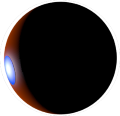MATT
a first terraformation

2036
The Mars Terraformer Transfer (MATT) is the first practical terraformation plan. It is patent-pending in the U.S., available for licensing by the Lake Matthew Team.
The Shepherd
The Shepherd uses a DE-STARLITE-class laser and a suite of commercial off-the-shelf (COTS) instruments for body deflection, tracking, physical characterization and restructuring. Commercial firms / units with ability to build the Shepherd include:
- Ball Aerospace – Space Sciences & Technologies
- Boeing Phantom Works
- Lockheed Martin – Space Systems
- Northrop Grumman – Space & Directed Energy Systems
- Orbital ATK – Space Systems Group
- SSL
Omaha Crater
In time, settlement industries will vent excess oxygen into the crater, forming a protective local ozone layer. Ozone, heat and the pressure of air and water set the stage for a photosynthetic archipelago on the open crater floor – a true terraformation site, with appearance similar to the masthead site, Alaska’s Aniakchak caldera.
The terraformation resources persist beyond our time. Omaha Crater bedrock will remain warm to the touch for thousands of years.
Water Domes
The notional subaqueous dome design has a low pressure differential across surfaces, to free domes from the radius-limiting scaling law of pressure vessels; thereby the domes can achieve unmatched mass efficiency at scale, roughly two orders of magnitude lighter than the equivalent pressure-vessel designs. Domes can scale to millions of cubic meters of pressurized interior space, while using only some hundreds of tons of cargo for construction. Omaha Crater’s interconnected hab network can have a total pressurized volume of roughly 100 million cubic meters, sufficient for Mars’ first city.
Such immense habs are feasible only with the resources created in terraformation. The scale is impractical beyond Omaha Crater, on unimproved ground; thus, every spacefaring organization will have reason to lease hab space at Omaha Crater.

2061
The 2061 construction crews can be flown and provisioned from the settlement city of the 2036 Omaha Crater, speeding development of the second crater. This second application of the invention’s methods can improve upon the first, potentially scaling settlement beyond Elon Musk’s ambition for a million settlers, in this century.

Google Books preview: Terraforming Mars
Wiley-Scrivener’s 2022 release of Terraforming Mars presents three interlocking chapters by G. Stewart, the inventor of the Mars Terraformer Transfer (MATT). These three chapters introduce the latest developments in the design for MATT’s implementation and utilization, for Omaha Trail high-efficiency Martian transport, for Omaha Field magnetostatic Martian subaerial cosmic ray protection, and for a “Red Gold” Martian precious metal industry with potential to bankroll other Martian ventures from the 2030s:
Stewart, G., 2021. Efficient Martian Settlement with the Mars Terraformer Transfer (MATT) and the Omaha Trail. Terraforming Mars, p.51.
Stewart, G., 2021. Omaha Field – A Magnetostatic Cosmic Radiation Shield for a Crewed Mars Facility. Terraforming Mars, p.283.
Stewart, G., 2021. Red Gold – Practical Methods for Precious-Metal Survey, Open-Pit Mining, and Open-Air Refining on Mars. Terraforming Mars, p.389.
These chapters point the way to a protected Martian settlement: a true city on Mars. It’s a city built with unprecedented, and highly beneficial, economy of rocket stages. When building a hab network with MATT and ISRU options, the Earth-launch rocket stage count can be two to four orders of magnitude smaller than that of a baseline SpaceX design; i.e., cutting Earth-launch rocket stages for hab construction by a factor of 100 to 10,000.
For chapter abstracts and volume details, see the December 9 2021 press release. Chapter manuscript PDFs are available from the author upon request.
If you find MATT interesting, please light a bright flare, with our thanks.
Contact Us
LakeMatthewTeam at gmail.com
Image credits:
- Roy Wood: Surprise Lake inside Aniakchak Caldera
- Optonicus Corporation: fiber-array laser system
- U.S. Army Center of Military History: Omaha Beach, map no. 6





